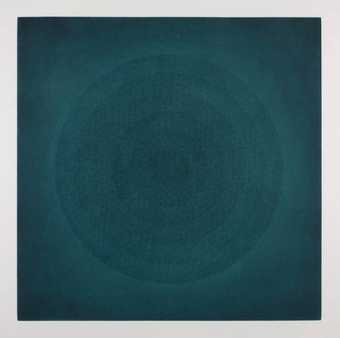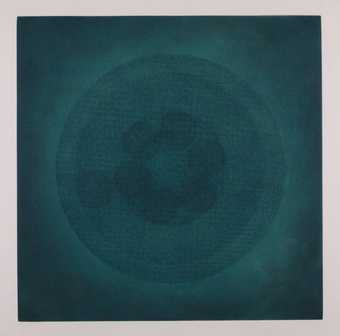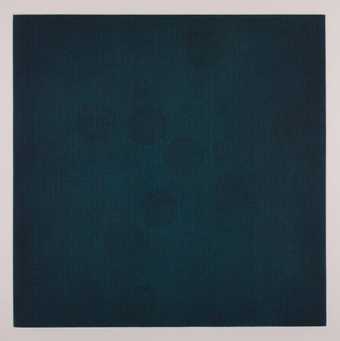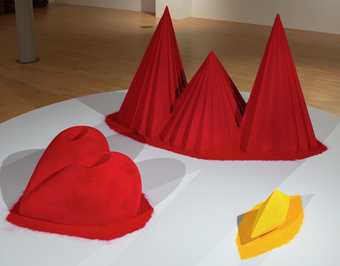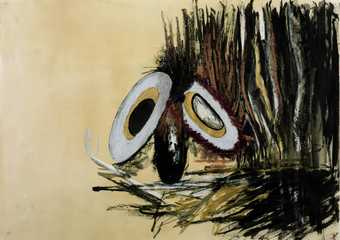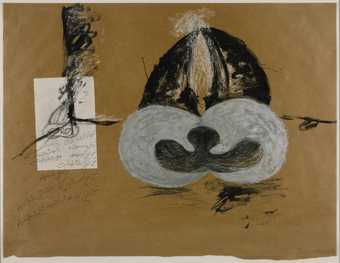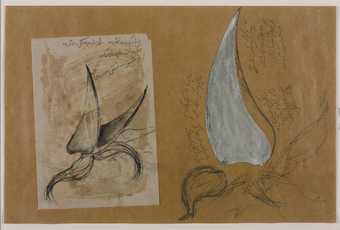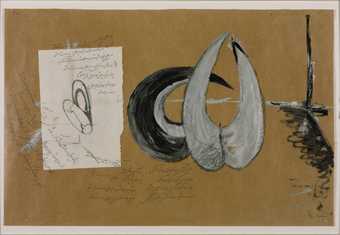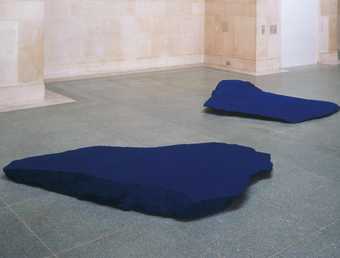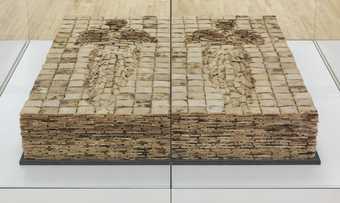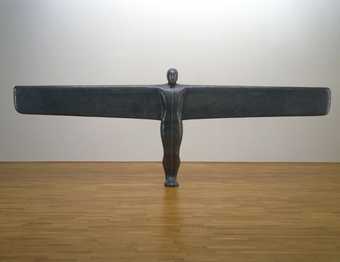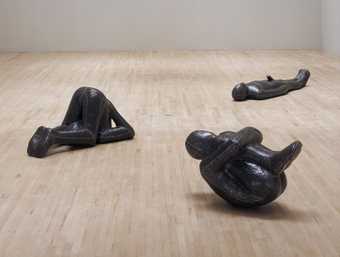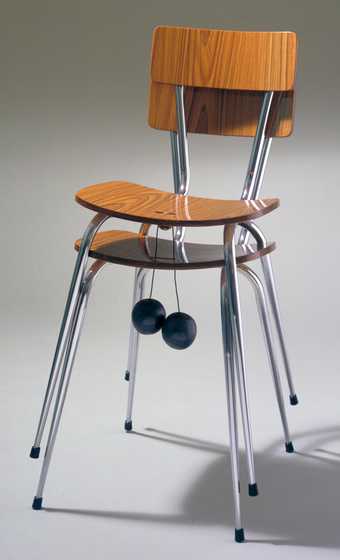
Not on display
- Artist
- Shirazeh Houshiary born 1955
- Medium
- Brass, zinc and plywood
- Dimensions
- Object: 1900 × 2000 × 2000 mm
- Collection
- Tate
- Acquisition
- Purchased 1987
- Reference
- T05022
Display caption
Houshiary was born in Iran but works in Britain. This is one of a series of sculptures of various sizes in which the wings of an angel symbolize force and energy. The image of a four-winged angel is derived from those found in Byzantine churches in Istanbul where two wings are directed towards earth and two point upwards to the sky. Power, according to the artist, lies at the meeting point.
Gallery label, August 2004
Does this text contain inaccurate information or language that you feel we should improve or change? We would like to hear from you.
Catalogue entry
T05022 The Earth is an Angel 1987
Brass and zinc over plywood 1900 × 2000 × 2000 (74 3/4 × 78 3/4 × 78 3/4)
Not inscribed
Purchased from Lisson Gallery (Grant-in-Aid) 1987
Exh: Shirazeh Houshiary: Breath, Lisson Gallery, Sept.–Oct. 1987 (3)
Lit: Sarah Kent, ‘Shirazeh Houshiary, Grenville Davey’, Time Out, 7 Oct. 1987, p.33; Richard Cork, ‘Angels of Earth’, Listener, 15 Oct. 1987, p.37; Tate Gallery Report 1986–8, 1988, p.90, repr. (col.); James Hall, ‘Forme Fatale’, Esquire, vol.2, May 1992, p.20, repr. (col.); Roger Bevan, ‘Schubert Holds “Closing Down Sale” of Landy; Lisson's On Kawara’, Art Newspaper, vol.3, no.18, May 1992, p.21. Also repr. Shirazeh Houshiary, exh. cat., Centre d'art contemporain, Geneva 1988, pp.6 (col.), 36, 37 (col.); Burlington Magazine, vol.130, April 1988, p.328 (col.); Artforum, vol.26, no.10, Summer 1988, p.97 (col.)
‘The Earth is Angel’ comprises four wing-shaped segments, two zinc and two brass, soldered together at a tapered middle point. The tips of the silver-coloured zinc wings overlap to form a point at the top of the sculpture, and the pink-coloured brass wings overlap to form a point at its base. The artist weighted the tips of the brass wings to give the piece greater stability. A tension between the upward movement of the zinc and the downward movement of brass arises from the way in which the segments have been positioned and joined. The zinc segments seem to be pointing to the sky and the brass segments to the earth. However, the brass segment at the front of the sculpture folds over the zinc segment furthest away from the viewer at the back, subtly counteracting this directional movement. The artist treated the brass with zinc chloride and copper nitrate to achieve the ‘fragile’ pink patina. It was then waxed for protection. The effect of the colour and arrangement of the segments is that of contrast and movement.
T05022 was made between 1986 and 1987 in the artist's studio, then in Orsman Road, London. A wooden frame, made by a fabricator, was covered with thin sheets of brass and zinc which the artist cut and soldered herself. The work took about six weeks to make.
Houshiary was born in Persia (now Iran) and has lived and worked in Britain since the mid-1970s. During the 1980s she gained recognition for works made of clay and straw that were partly influenced by Persian legends and Islamic calligraphy (see, for example, ‘Listen to the Tale of the Reed’, 1982, a series of six large sculptures shown in Summer Show 3, Serpentine Gallery, 1982). In 1984 she began experimenting with other materials such as zinc and copper, which made her work appear harder and sharper. At the time Lynne Cooke commented:
While arcs, acute angles and straight edges comprise the profiles of these new works, they do not however entirely lose an organic feel and become mechanistic. Because each silhouette has been made by wrapping the edges of the sheet around the inner wooden form and nailing it into place, they thus bear the imprint of the hand, albeit with the intervention of tools.
(Lynne Cooke, Shirazeh Houshiary,
exh. cat., Lisson Gallery 1984, p.16)
Houshiary, who no longer physically makes her sculptures, told the compiler that the organic shapes characterising her work of the mid-1980s, could only be made by hand.
The poems of the thirteenth-century Sufi mystic Jalalu'ddin Rumi have inspired Houshiary's world view and have provided a starting point for her work. She began to read them when she was seven or eight years old. Sufism, the mystical tradition of Islam, means ‘the way’ or ‘the path’, a way of being in the world and having contact with the centre of one's being. Houshiary believes that this quest for self-knowledge is common to most world religions, and so, although she is inspired by her particular heritage, she does not set out to celebrate a national cultural identity. In conversation on 27 August 1994 she told the compiler that her aim has been to ‘unveil’ shared human truths by uncovering symbols that are universally recognised. She has said, ‘An artist is someone who is capable of unveiling the invisible, not a producer of art objects ... In my work there is a continual invention of already existing forms and symbols precisely because the problem is not to be original, or indeed to establish a distinction between forms of knowledge, between East and West’ (Virginia Button, The Turner Prize 1994, exh. cat., Tate Gallery 1994, p.11).
‘The Earth is an Angel’ is one of a number of sculptures and drawings executed approximately between 1985 and 1987 in which the artist explored the symbolic idea of the angel. Most of the sculptures were exhibited in Houshiary's exhibition organised by the Centre d'art contemporain in Geneva, and all of them are documented, with several of the drawings, in the accompanying catalogue. Some of the sculptures refer specifically to an angel or angel's wings in their titles. These include ‘The Round Angel’, 1986 (repr. p.14 in col.), ‘Distance is Lit by Round Wings’, 1986 (repr. p.30). ‘The Angel of Thought’, 1987 (repr. p.11), ‘Round Wings’, 1987 (repr. p.28 in col.), ‘The Angel with Ten Thousand Wings’, 1987 (repr. p.32 in col.), ‘Beating of her Wings’, 1987 (repr. p.37 in col.) and ‘Dark Angel’, 1987 (repr. p.44). All of the works gathered for the exhibition and catalogue share a simlar visual language of predominantly curved, folded and pointed forms. With its circular forms ‘In Suspense’, 1987 (repr. p.44), for example, relates closely to ‘Dark Angel’. Other works such as ‘Between Earth and Sky’, 1987 (repr. p.51 in col.) address the notion of ascending and descending, the state of being between heaven and earth, which is connected to Houshiary's understanding of the idea of the angel. This state of being between spirit and matter informs the compositional structure of T05022. It is also implied by the artist's choice of materials, which, she told the compiler, were selected for their colour contrasts. The pink patina of the brass wings, for example, suggests flesh while their flame-like forms connect them with the earth. In contrast, the silver-coloured wings are ‘like the white of moonlight’ and have celestial connotations.
According to the artist, ‘The Earth is an Angel’ and ‘Beating of her Wings’ are very similar works in that they both interpret the angel as an energy or life force. Both rest on points to give the impression that they are suspended. In ‘Beating of her Wings’ the artist particularly wanted to suggest the sound of beating wings (see entries in this volume on the related drawings, T05014-T05017). The sculpture is complex and intricate in form. Long tapered pieces of copper curl at its base like strands of hair or a tail of feathers. The artist wanted the sculpture to evoke the form of a musical note floating on a sheet, or like a sound hovering in the air. In contrast, a work such as ‘The Angel with Ten Thousand Wings’ is concerned with the image of the wing itself.
There is one work on paper with the same title as T05022 (T05013, see earlier entry). In this work a four-winged form, comprised of two black wings and two gold, is depicted resting on a flat surface in an enclosed space. In the sculpture the tips of the wings made of the same material overlap at top and bottom. In T05013 the tips of the opposite material or colour overlap. Houshiary's mixed media drawings addressed the same themes as her sculptures but they did not functions as preliminary studies, rather they allowed her to explore the themes independently of the sculptures.
Houshiary's decision to investigate the angel as a subject was stimulated partly by her interest in universal symbols. She discovered that the notion of the angel originated five to six thousand years ago and developed in different cultures. Belief in spiritual beings that mediate between the realm of the sacred or holy and the physical domain, has existed throughout the history of the main world religions. From earliest times such spiritual beings were represented as having wings. The ancient Egyptians, for example, represented the battling sun-god Horus of Edfu as a winged disk (see The New Encyclopaedia Britannica: Macropaedia, 1975, I, p.874). But it was Christian art in particular that gave the concept of the angel its most coherent visual form. In Christian iconography angels are generally represented as winged human figures. Houshiary learnt, however, that in Byzantine and early Renaissance art angels were represented in a more abstract manner, one which was closer to Islamic conceptions. Seraphim and cherabim, for example, were depicted as having only heads and up to three pairs of wings (see James Hall, Dictionary of Subjects and Symbols in Art, 1994, p.17). Houshiary also became interested in the attempts in Christian art to represent the Holy Ghost.
The term angel is derived from the Greek word ‘angelos’ and has its equivalent in the Hebrew word for messenger ‘mal'akh’. The role of the angel is to reveal the purpose and destiny of mankind. Angles are therefore instrumental in an individual's quest for self-knowledge. For Houshiary art is an activity which enables the artist to document this quest and can be regarded as an expression of the individual's longing for reunion with his or her divine self. She told the compiler, ‘I think the image of the angel is probably the image of the divine self, ultimately, and to understand it one has to understand oneself, to understand one's own angel’.
Sufi mystics thought of the angel as the divine name (or holy spirit) invested in each individual, the ‘invisible master’ or the ‘Gabriel of your being’ (see Henry Corbin, Creative Imagination in the Sufism of Ibn ‘Arabi, trans. Ralph Manheim, Princeton 1969, pp.34–5). The figure of the angel Gabriel appears in all the Abrahamic religions. He appears in the Old Testament wrestling with Jacob and in the New Testament as the messenger of the Annunciation. He also occupies a special place in Islam as the messenger of Allah, revealing the Koran (Islamic scriptures) to the prophet Muhammad. Jacob's contest with Gabriel described in Genesis has been compared with the Sufic striving to become aware of the divine self. The Sufi scholar Henry Corbin (1969, p.35) describes Jacob's struggle as
the intellective soul struggling to be united with the Angel, with the active Intelligence, until the rising of the light ... at which time the soul emerges, delivered, from the darkness that imprisoned it. Thus no doubt we should speak not of a combat with, that is against, the Angel, but of a combat for the Angel, for the Angel in turn needs the response of a soul if his being is to become what it has to be.
The montheistic religions of Judaism, Zoroastrianism, Christianity and Islam share a tripartite view of the universe comprising the celestial, terrestial and subterrestial realms. The conflict between body and spirit that this division engenders has been a recurring subject of art. In conversation with the compiler the artist referred to Plato's interpretation of this human condition, which describes Psyche (the soul) as trapped in the body, forever separated from Eros and, thus, from spiritual wholeness (see Jane Davidson Reid, The Oxford Guide to Classical Mythology in the Arts 1300–1990s, 1993, II, pp.939–40). Houshiary observed that ‘The Earth is an Angel’ sits on points, rather than a base, giving an impression of lightness. At the same time, it conveys a sense of weight constantly pulling downwards. This, she felt, represented ‘the whole image of the body and soul and their struggle’.
Houshiary told the compiler that in ancient Islamic thought angels are associated with the four elements. The subject and title of T05022 were chosen to evoke this symbolic meaning, described by an Iranian Sufi during the fifteenth century in the following terms (see Corbin 1969, p.346):
There are four degrees (or planes) to which the four letters ALLH (Allah) refer, namely the heart ..., the intelligence ..., the spirit ... and the soul ...And there are four angels that are the vehicles of these four degrees. The heart is the side of Gabriel, for the heart is the abode of knowledge and Gabriel is its mediator ... The intelligence is the side of Michael ... The spirit is the side of Seraphiel ... The soul is the side of Azrael ... According to the same homology, in the world of natural Qualities (or Elements), Water is the form of Gabriel, Earth is the form of Michael, Air is the form of Seraphiel and Fire is the form of Azrael.
For the artist the angel is a primordial quality, a product of human imagination. She believes that the angel was created so that man could recognise his divine self. The writings of Henry Corbin provided Houshiary with an interpretation of the concept of ‘The Earth is an Angel’, in which he identified the notion that the earth was represented by an angel with the concept of ‘Sophia’ or creative imagination (see Corbin 1969, Chap.2, ‘Sophiology and “Deviotio Sympathetica”’, pp.136–75). Like the Earth, generally personified as a feminine force, the creative imagination is often seen as having a feminine identity. The creative imagination becomes the tool by which the individual can be reunited with his or her divine self. In ‘The Earth is an Angel’ Houshiary attempted to represent the creative imagination symbolically in its struggle to release the spirit from the Earth. In conversation with the compiler on 19 October 1994, she stressed that this was not intended to be in any way a negative image, as she believes that ‘self-existing opposites’ represent the nature of creativity.
After making ‘The Earth is an Angel’ the artist was sent a postcard of Giotto's ‘St Francis Receiving the Stigmata’ at San Franceso, Assisi. In this fresco, painted in the late thirteenth century, St Francis is shown receiving the stigmata from a composite figure of a seraph and a man with three pairs of wings. This heavenly being hovers with one pair of wings pointing towards the earth, one pair supporting his middle and the third pair pointing to the heavens. The wings create a shape similar to that of ‘The Earth is an Angel’ (see Osvald Sirén, Giotto and Some of His Followers, 1917, II, pl.52). The artist felt that Giotto's painting also represented the concept of the ‘The Earth is an Angel’, a realisation of the divine self.
Houshiary's understanding of the idea of the angel was also particularly influenced by an essay on the Archangel Gabriel in Corbin's The Purpled Archangel, which she studied around the time she was making T05022 (L'Archange empourpré: Quinze traités et récits mystiques, Paris 1976). This essay, ‘The Sound of Gabriel's Wing’, by the Sufi mystic Shihabuddin Yaha Surawardi, can also be found in The Mystical and Visionary Treatises of Shihabuddin Yaha Suthrawardi (trans. W.M. Thackston, 1982, pp.26–34). Surawardi's text is a meditation on why Sufis call certain sounds the ‘sound of Gabriel's wing’. He writes (p.32–3):
Gabriel has two wings ... The right is pure light, the totality of which is an abstraction of the relation between his being and God. The left wing has traces of darkness, like the dark spots on the surface of the moon that resemble peacock's feet ... the vainglorious world of sound and shadow is Gabriel's wing, that is, his left wing, while enlightened souls are from his right wing.
The artist has approved this entry.
Published in:
Tate Gallery: Illustrated Catalogue of Acquisitions 1986-88, London 1996
Explore
- abstraction(8,615)
-
- from recognisable sources(3,634)
- non-representational(6,161)
-
- colour(2,481)
- irregular forms(2,007)
- universal concepts(6,387)
- mysticism(2,612)
-
- spirituality(739)
- Islam(39)
- angel(267)
- social comment(6,584)
-
- gender(1,689)
You might like
-
Shirazeh Houshiary [no title]
1992 -
Shirazeh Houshiary [no title]
1992 -
Shirazeh Houshiary [no title]
1992 -
Sir Anish Kapoor CBE RA As if to Celebrate, I Discovered a Mountain Blooming with Red Flowers
1981 -
Shirazeh Houshiary The Angel of Thought
1987 -
Shirazeh Houshiary The Earth is an Angel
1987 -
Shirazeh Houshiary Beating of her Wings II
1987 -
Shirazeh Houshiary Beating of her Wings III
1987 -
Shirazeh Houshiary Beating of her Wings IV
1987 -
Sir Anish Kapoor CBE RA A Wing at the Heart of Things
1990 -
Sir Antony Gormley OBE RA Bed
1980–1 -
Sir Antony Gormley OBE RA A Case for an Angel III
1990 -
Sir Antony Gormley OBE RA Three Ways: Mould Hole and Passage
1981–2 -
Richard Wentworth Siege
1983–4 -
Shirazeh Houshiary Veil
1999

